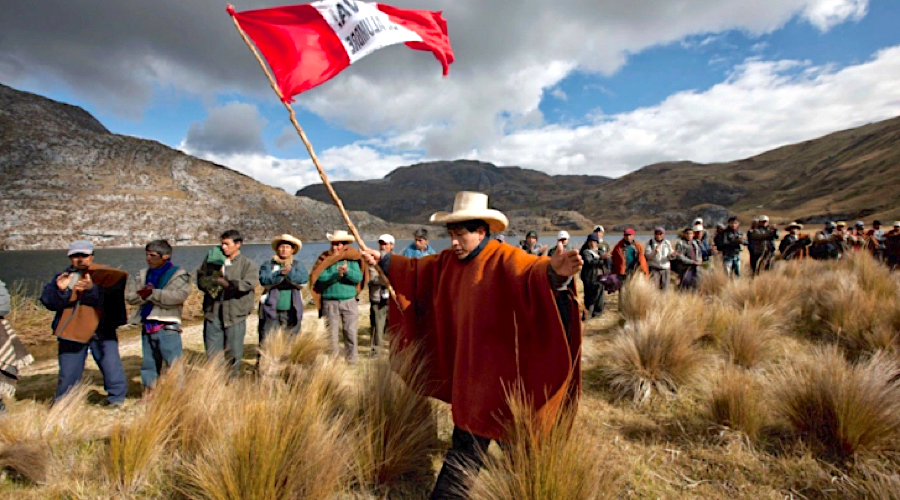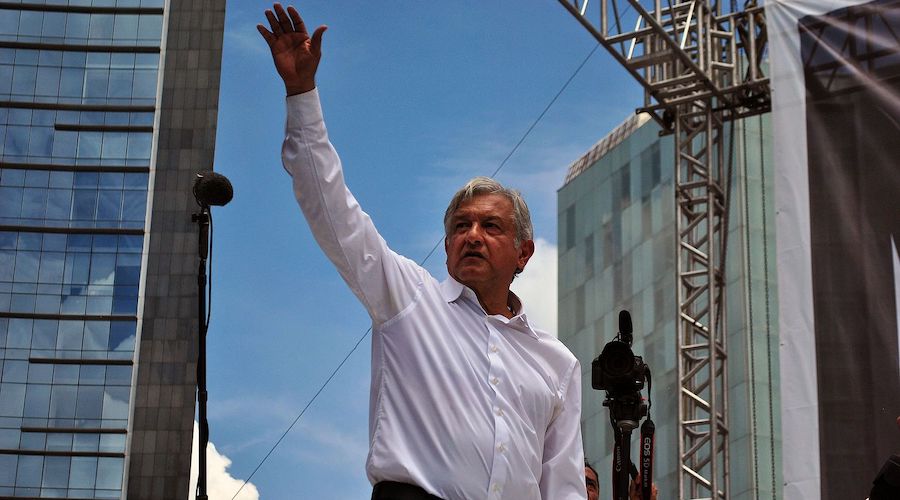Cecilia Jamasmie | August 19, 2021 |

Newmont walked away from the $5bn Conga copper-gold project in Peru in 2016, due to relentless community opposition. (Image: Screenshot via YouTube.)
A move towards resource expropriation, tax and royalty increases, as well as demands for local participation in companies’ ownership, all resource nationalism components, continue to increase, with Latin America taking centre stage, a new study shows.

According to the latest report from risk consultancy Verisk Maplecroft, there is a clear four-year trend in minerals-rich nations to seek greater control over the revenues generated by their natural resources, which is expected to increase over the next two years.
The consultancy identified 66 countries out of the 198 included in the resource nationalism index (RNI), or 33% of them, that have tightened the grip on their riches since 2017.
LATIN AMERICA IS THE JURISDICTION WHERE RISKS OF EXPROPRIATION AND TAXES HIKES HAVE INCREASED THE MOST IN THE PAST FOUR YEARS
Latin America is the jurisdiction where risks of expropriation and taxes hikes have increased the most, the study says. Mexico stands out as seeing the nation where the risks have climbed the most, driven by López Obrador administration’s nationalist agenda that wields community and environmental arguments as justification for greater state involvement in the extractive sector, Verisk Maplecroft says.
Mexico’s situation is indicative of a wider regional trend affecting miners and energy firms in the region. South America’s three largest economies, Brazil, Argentina and Colombia are also experiencing substantial negative shifts in the index, while the once stable mining destinations of Chile and Peru are in the midst of political changes that threaten to alter the operating environment for the industry.

Courtesy of Verisk Maplecroft. (Click to enlarge)
Copper prices have soared to record highs this year, handing unions in the two largest producers of the metal — Chile and Peru — additional leverage. The price rally has also ratcheted up tensions in labour negotiations and put pressure on global supply of the red metal.
Verisk Maplecroft’s RNI tracks incidents of direct expropriation and nationalization. The highest scores go to cases where there hasn’t been adequate compensation, no compensation, or in which a government hasn’t paid an award to a company following arbitration.
The ten highest risk countries in the latest edition of the index are Venezuela, Tanzania, Mexico, PNG, Zambia, Russia, North Korea, Kazakhstan, DRC and Zimbabwe.
The motive behind direct expropriation could be short-term political gain or a genuine attempt to save a vital but ailing industry to support the national interest. “The adequacy of compensation is the key factor from a business perspective,” the consultancy says.
Politics and community pressure
In Latin America, the push to gain greater benefit from natural resources generally hinges on two factors. In Mexico and Argentina, the main driving force is ideology, while in Colombia and Chile pressure comes from communities — both those hosting mining projects and civil society.
“While the traditional bastions of stability for Latin America’s mining investors are not yet crumbling, they appear to be joining their regional peers on the path of greater resource nationalism,” the report reads. “Only time will tell how far each one goes down this road.”
In Africa, motivations are much more diverse. The interventionism seen in Liberia and Mauritania is driven by structural governance shortcomings, not nationalist sentiment, Verisk Maplecroft points out.
The line between resource nationalism and legitimate national interest isn’t always easy to draw, and this can exacerbate tensions.
What is key for miners, according to the report, is to detect the signals early on, so that companies can adapt their investment strategies and exploration portfolios to mitigate future exposure to nationalism trends.
By doing so, the consultancy concludes, companies can also prioritize investment in jurisdictions where they can be part of the solution. They can work with local stakeholders to find a balance between community needs and industry profitability to secure long-term social license to operate.
Mexico leads LatAm push for more control of resource revenue
Copper prices have soared to record highs this year, handing unions in the two largest producers of the metal — Chile and Peru — additional leverage. The price rally has also ratcheted up tensions in labour negotiations and put pressure on global supply of the red metal.
Verisk Maplecroft’s RNI tracks incidents of direct expropriation and nationalization. The highest scores go to cases where there hasn’t been adequate compensation, no compensation, or in which a government hasn’t paid an award to a company following arbitration.
The ten highest risk countries in the latest edition of the index are Venezuela, Tanzania, Mexico, PNG, Zambia, Russia, North Korea, Kazakhstan, DRC and Zimbabwe.
The motive behind direct expropriation could be short-term political gain or a genuine attempt to save a vital but ailing industry to support the national interest. “The adequacy of compensation is the key factor from a business perspective,” the consultancy says.
Politics and community pressure
In Latin America, the push to gain greater benefit from natural resources generally hinges on two factors. In Mexico and Argentina, the main driving force is ideology, while in Colombia and Chile pressure comes from communities — both those hosting mining projects and civil society.
“While the traditional bastions of stability for Latin America’s mining investors are not yet crumbling, they appear to be joining their regional peers on the path of greater resource nationalism,” the report reads. “Only time will tell how far each one goes down this road.”
In Africa, motivations are much more diverse. The interventionism seen in Liberia and Mauritania is driven by structural governance shortcomings, not nationalist sentiment, Verisk Maplecroft points out.
The line between resource nationalism and legitimate national interest isn’t always easy to draw, and this can exacerbate tensions.
What is key for miners, according to the report, is to detect the signals early on, so that companies can adapt their investment strategies and exploration portfolios to mitigate future exposure to nationalism trends.
By doing so, the consultancy concludes, companies can also prioritize investment in jurisdictions where they can be part of the solution. They can work with local stakeholders to find a balance between community needs and industry profitability to secure long-term social license to operate.
Mexico leads LatAm push for more control of resource revenue
Reuters | August 18, 2021

Mexican President Andrés Manuel López Obrador. (Image by ProtoplasmaKid, Wikimedia Commons)
Latin American governments have increasingly sought more control of their mining and energy revenue over the past few years, with Mexico leading the pack according to the latest Resource Nationalism Index rankings published by Verisk Maplecroft on Wednesday.

The report said environmental concerns as well as those from local communities increasingly play a bigger role in influencing policy shifts.
Over the past four years, Mexico has risen the most in the ranking, which is currently led by Venezuela. Argentina was placed in the top 20 for the first time after coming in at No. 81 out of 198 countries in the third quarter of 2018.
The rankings represent the level of risk to business from governments taking greater control of economic activity and revenue generated in extractive industries, Verisk Maplecroft said.
The measurements take in to account state drivers, participation in extraction and expropriation outcomes. The higher a country’s ranking, the greater the perceived risk.
THE RISK INCREASE COMES AS COMMODITY PRICES MEASURED BY THE REFINITIV/CORECOMMODITY CRB INDEX THIS QUARTER HIT THE HIGHEST LEVEL SINCE 2015
Mexico’s rise from 101 in 2018’s third quarter to No. 3 at present is driven by President Andres Manuel Lopez Obrador’s “nationalist agenda,” according to the analysis.
“A legislative proposal (now stalled) to nationalize lithium indicates AMLO’s interventionism is all but certain to expand beyond oil and gas in the second half of his term,” the report noted, using an abbreviation for Lopez Obrador.
Mexico’s president has argued that his push to bolster state companies aims to balance a market that has been skewed in favor of the private sector.
In the case of Argentina, Verisk Maplecroft said President Alberto Fernandez’s intervention in multiple sectors is the source of the increased risk.
“Because intervention has largely ideological and political motivations, we expect it to intensify as the government heads into the second half of its term, regardless of the outcome of the November midterms.”
The report notes, however, that Brazil and Colombia, which are led by center-right governments as opposed to the left-leaning Mexico and Argentina, are also seeing an increase in risk for investors in resource sectors.
“The once stable mining destinations of Peru and Chile are on the cusp of political changes that will alter the operating environment for the industry,” said the report.
Peru’s president, Pedro Castillo, sworn in late last month, campaigned partly on the promise of keeping for the country a larger chunk of the revenue derived from mining. Legislation along the same lines is being discussed in Chile, the world’s largest copper producer.
Ecuador, bucking the regional trend, dropped from No. 3 in 2017 to a current rank of 74.
A third of the countries assessed show increasing risks for business over the past four years as governments aim to take more control of revenue associated with extracting industries. About a fourth showed a decrease in such risks.
The risk increase comes as commodity prices measured by the Refinitiv/CoreCommodity CRB index this quarter hit the highest level since 2015. The index last year hit its lowest level in records dating back to 1994.
The MSCI Global Metals and Mining Producers ETF in May hit its highest price since early 2012, while the MSCI Global Energy Producers ETF has nearly doubled in price from depths hit in March 2020.
(By Rodrigo Campos; Editing by Matthew Lewis)
No comments:
Post a Comment